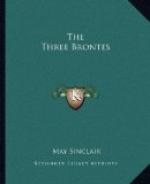It is the living sister speaking for the dead; for Charlotte herself had little of Emily’s fine Paganism. But for one moment, in this lyric passage, her soul echoes the very soul of Emily as she gathers round her all the powers and splendours (and some, alas, of the fatal rhetoric) of her prose to do her honour.
It is not only in the large figure of the Titan Shirley that Charlotte Bronte shows her strength. She has learnt to draw her minor masculine characters with more of insight and of accuracy—Caroline Helstone, the Yorkes, Robert Moore, Mr. Helstone, Joe Scott, and Barraclough, the “joined Methody”. With a few strokes they stand out living. She has acquired more of the art of dialogue. She is a past master of dialect, of the racy, native speech of these men. Not only is Mr. Yorke painted with unerring power and faithfulness in every detail of his harsh and vigorous personality, but there is no single lapse from nature when he is speaking. The curates only excepted, Charlotte never swerves from this fidelity. But when she is handling her curates, it is a savage and utterly inartistic humour that inspires her. You feel that she is not exercising the art of comedy, but relieving her own intolerable boredom and irritation. No object could well be more innocent, and more appealing in its innocence, than little Mr. Sweeting, curate of Nunnerly. Mr. Sweeting at the tea-table, “having a dish of tarts before him, and marmalade and crumpet upon his plate”, should have moved the Comic Spirit to tears of gentleness.
Curates apart, two-thirds of Shirley are written with an unerring devotion to the real, to the very actual. They have not, for all that, the profound reality of Jane Eyre. The events are confused, somehow; the atmosphere is confusing; the northern background is drawn with a certain hardness and apathy of touch; the large outlines are obscured, delicate colours sharpened; it is hard and yet blurred, like a bad steel engraving. Charlotte’s senses, so intensely, so supernaturally alive in Jane Eyre, are only passably awake in Shirley. It has some of the dulness of The Professor, as it has more than its sober rightness. But, for three-and-twenty chapters, the sobriety, the rightness triumph. There are no improbabilities, no flights of imagination, none of the fine language which was the shame when it was not the glory of Jane Eyre.
Then suddenly there comes a break—a cleavage. It comes with that Chapter Twenty-four, which is headed “The Valley of the Shadow of Death”. It was written in the first months after Emily Bronte’s death.
From that point Charlotte’s level strength deserts her. Ever after, she falls and soars, and soars and falls again. There is a return to the manner of Jane Eyre, the manner of Charlotte when she is deeply moved; there is at times a relapse to Jane Eyre’s worst manner. You get it at once in “The Valley of the Shadow” chapter, in the scene of Caroline’s love-sick delirium.




